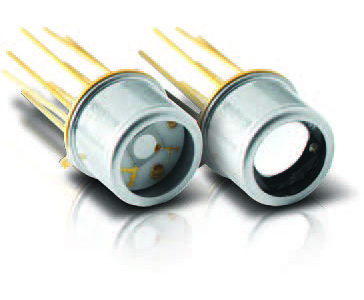
QS
2D CAD file (PDF)
- 9113A
- English
Discrete pyroelectric sensor with metallic coating. Low noise level.
From 0.1 to 1000 µm
TO5 and TO8 packages make the QS-H detectors small and easy to integrate in an existing system.
5 mm and 9 mm diameter pyroelectric sensors make optical alignment easier.

Permanent window for TO5-based or TO8-based QS detectors.

Hardshell, waterproof carrying case with padded dividers. Internal size 13 L (351 mm x 236 mm x 157 mm).
There is no user manual available for this product.





There is no document to download for this product. Contact us for technical details.

Our pyroelectric detectors are a class of room temperature thermal detectors that produce a current output that is directly proportional to the rate of change of temperature when exposed to a source of radiation. They are best described by an AC current source, capacitor and resistor. Their current output is governed by the equation I = p(T)·A·dT/dt, where I is current, p(T) is the pyro coefficient, A is the area as defined by the front electrode, and dT/dt is the rate of temperature change of the pyro crystal. The advantages of a pyroelectric detector over other IR detectors are: room temperature operation, broad spectral response, high sensitivity (D*) and fast response (sub-nsec into 50 Ω).

Our passive discrete pyroelectric detectors range from 5 to 9 mm in diameter and are provided in two configurations: high sensitivity or high average power. They present a pyroelectric detector element covered with our metallic coating (MT) and are packaged in a miniature TO-5 or TO-8 can. The diagram shown left identifies the pin-out for both types of detectors. Our organic black coating (BL), increases the optical absorption and helps flatten the spectral response. We also offer a number of permanent IR Windows that can be added to the TO can. These discrete pyro detectors are ideal for pulsed laser applications.

Unlike photoconductive and photovoltaic detectors, our pyroelectric thermal detectors are not limited to a small part of the electromagnetic spectrum. They are truly broad spectrum detectors, sensitive from 0.1 μm to 3000 μm (EUV, FAR IR, and THz). Any and all radiation absorbed by our coatings or pyro crystal will result in a measurable signal. The two plots at the left show the relative spectral response of detectors with MT and BL coatings. Note that the well documented, NIST traceable calibrated portion of these curves runs from 0.25 μm to 15 μm. There are currently no traceable optical standards for measurements > 15 μm.
*Does not include shipping fees, import fees or local representation. Request quote for full details and local sales contact.
You might need these specific products to be able to use the placeholder only.
No compatible product